Grass seed, like any living organism, has the potential to die if not properly cared for. While lawn seed is generally resilient and can withstand some adverse conditions, there are certain factors that can cause it to die before it has the chance to grow into a lush, green lawn.
What can cause a grass seed to die?
A grass seed is like a battery, it contains within it the necessary reserves of nutrients that will give energy to the grass plant as germination is initiated. The energy is stored in the form of starch which provides a source of energy for the seed embryo. As the seed develops its first leaf and roots the energy for this will come from reserves within the seed. The grass plant needs to develop roots quickly so that it can start to take nutrients from within the soil.
What goes on within a seed when it germinates is a complex set of biological chemical reactions which all have to come together perfectly for germination to happen. Various enzymes within the seed react to degrade the starch and provide a food source for the seedling. Over time, it is possible that any of these elements can begin to degrade. The result being anything from slower germination to no germination at all.
The rate at which this can happen is unpredictable. It can vary between individual crops of seed and between different species. Another big factor that influences the long term viability is how the seed is stored. As part of a registered seed merchant, all the grass seed you buy from Grass Seed Online has been germination tested. We periodically retest our seed as required to ensure that it still maintains suitable germination. We try to use fresh seeds whenever we can to ensure best performance.
I have sown my grass seed and nothing is happening. Is my lawn seed dead?
The chances are it is not dead, its is simply waiting for the ideal conditions to come together for it to germinate. The envorinmental factors in the area where the seed has been sown play a huge part in initiating the seedling germination process. If any of these are missing or reduced, it will have an impact on the seed. Usually the seed will germinate, but it will take long and initial establishment will be slower.
What conditions does grass seed need to germinate?
Temperature
Temperature acts as a catalyst for the chemical reactions going on within the seed. Generally, the lower the temperature, the slower the germination. Perennial Ryegrass will germinate at the lowest temperature of the common grass seed varieties used in the UK. Other grass seed options such as fescues and bents require higher temperatures. Germination temperature range of different seed types is detailed below.
- Perennial ryegrass: 7°C (with a germination period of 7-14 days)
- Red fescues: 11°C (with a germination period of 11-21 days)
- Bent: 15°C (with a germination period of 11-21 days)
Other species such Smooth Stalked Meadow Grass and Tall Fescue seeds require warm conditions beyond that of Bentgrass. Therefore these can be slow to germinate unless sown in the summer months. Outside of the above times, grass seed will germinate but is can be a matter of weeks.
It is not always a case of the higher the better when it comes to temperatures for grass seed germination process. If the temperature is too high then soil moisture can be rapidly depleated, meaning it is crucial to have water on standby.
Some areas will naturally be colder than others and will take longer for the seed to germinate. Areas that are in the shade, wet or clay soils will all be cooler (especially in the spring months). With shade in mind, fence shade or are shade between buildings will cause germination to be slower.
Moisture
Keeping you seed moist is critical in initiating seed germination and ensuring successful establishment. When establishing a lawn from grass seed, the seed will need to be kept moist to ensure the growth process continues. Over watering can cause seed to become washed away and in can sometimes slow germination. If watering with mains tap water, the water is usually a very low temperature, this can lower thew soil temperature and slow the germination. When to comes to watering, nothing ever beats natural rainwater.
A great way to ensure the seed is kept moist is to ensure is it incorporated into the to 15mm of the soil surface. If you can roll the seed in or lightly tread it, this will compress the soil around the seed. Any seed that is left on the soil surface will quickly dry out and is unlikely to germinate.
One way to preserve adequate moisture is to cover the ground and the seed with polythene sheeting to prevent evaporation. This will create a humid environment which is ideal for germination. But once the seed has germinated, be sure to remove the sheeting one the seed is up and away. Covering seed with polythene sheeting can be a big help, but it can create the perfect environment for fungal turf diseases.
Air
A germinating seedling needs air, specifically oxygen, to survive. Plants are like any other living organism in that they require air for respiration. There is usually a readily available supply of oxygen for available, so this is rarely a problem. However if the seed is sown and the ground becomes saturated, then this will restrict the availability of oxygen to the plant.
So whilst nobody would usually attempt to sow seed in waterlogged ground conditions, it can happen post sowing if torrential downpours occur. The only defence is to wait until a period of favourable weather is forecast and try to ensure that the ground is in a favorable condition so that any excess water can drain away.
Sunlight
Some seeds do require stimulation by sunlight to initiate germination, this is not the case with grass seed. However if there is a lack of direct sunlight we can start to run into issues of shade. Fence shade, shade from trees, shade from objects such as buildings all have an impact on grass growth. Even in areas that are in partial shade will be affected to an extent.
Grass needs direct sunlight to photosynthesise. The amount of sunlight a plant requires is reffered to as Daily Ligh Integral, DLI for short. In lower light conditions grass plants will tend to become taller and more open, as the plant tried to reach up to find light. This results us reduced plant density that invariable leads to a more open sward, invasion of weeds and sometimes loss of grass cover.
What can I do to help my seed germinate?
- Before is germinates ensure that there is adequate moisture availabele to the plant. Try to ensure the seed is incorporated into the top 15mm and that the soil is kept moist.
- Sow when some rain is on its way. Nothing beats natural rain fall for making seed grow!
- Sow it when the soil temperatures are war enough. Perennial ryegrass will be the first to germinate and this will occur when soil temperatures are at 7 degrees Celsius and above.
- For small areas you can cover with a sheet to trap mositure and warmth in. But remmber to remove the sheeting once the seed has germinated.
- Waiting for the perfect conditions can be tough, but its the best way to ensure good germination.
Grass seeds and their potential dangers for dogs
Is grass seed safe for dogs and can I sow grass seed if I have a dog? Grass seeds pose a potential danger to dogs as they can cause severe irritation and a range of health issues. When the seeds become trapped in a dog’s fur, they can easily work their way into the ear canal, leading to irritation, inflammation, and potentially even ear infections. Ingestion of grass seeds can lead to abscesses in the lungs, which can be a serious and potentially life-threatening condition. If a seed gets into a dog’s eye, it can cause corneal abrasions and ulcerations, leading to vision loss if not promptly addressed.
Symptoms to look out for include excessive scratching or pawing at the ear, shaking of the head, coughing, difficulty breathing, and squinting or excessive tearing in the affected eye. If left untreated, the long-term effects of grass seeds on a dog’s health can include chronic ear infections, chronic respiratory issues, and even permanent vision impairment.
It is crucial for dog owners to carefully check their pet’s fur for any grass seeds and to seek veterinary attention if they suspect their dog has come into contact with them. By being aware of the dangers and symptoms associated with grass seeds, dog owners can take proactive steps to protect their pet’s health.
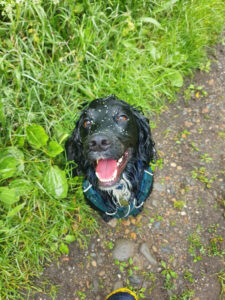
Dog with grass seed stuck in fur.
When can grass seed be a problem for my dog?
Generally speaking there are two types of grass that your dog might come into contact with:
- Short mown grass, i.e. lawns and parks
- Unmown grass, i.e. tall grass alongside footpaths, in fields/paddocks and around the countryside
Short mown grass is very unlikely to cause any problems as regular mowing of the grass will prevent seed heads from developing. However the tall grass you would find out in the countryside is where a dog is most likely to come into contact with grass seed, especially during the summer months.
When grass is allowed to grow tall it will produce a seed head that reaches maturity around July. Brushing against the grass can case loose seeds to come into contact with the dog.
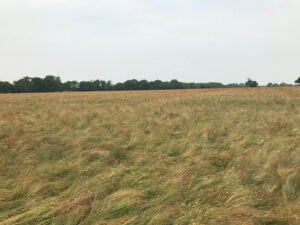
A field of long grass with ripe seedheads should be avoided as the seed can become lodged in the dogs fur.
Sowing grass seed and dogs
When sowing a lawn with grass seed there is going to be plenty of seed close to the surface that could potentially get lodged in a dogs paw. Below are our top tips to minimise the risk of grass seed getting stuck in a dogs paw:
- The most obvious one – keep the dog off the area for as long as practically possible.
- Try to incorporate the seed into the top 15mm of the soil. The less seed that is left on the surface, the less chance if it coming into contact with the dog.
- Try to use a grass seed mixture that is fast to germinate and will cover over the soil quickly. A mixture that contains Perennial Ryegrass will germinate and establish in the quickest possible time. This means that any loose seed will soon be covered by the grass leaf blades. Mixtures containing Perennial Ryegrass, like our Hardwearing Lawn Seed, are also great for lawns with dogs, as Perennial Ryegrass is the most hard wearing grass seed.
Is your grass seed treated with chemicals?
The grass seed we supply at Grass Seed Online does not have any chemicals applied to it. Regulations surrounding the use of chemicals on seed are stringent. Whilst it is common practice for farmers to use seed that has been treated with chemicals, the same is not true of grass seed. There are no pesticide products approved for use on grass seed.
Some grass from other sources may come treated with fertilisers or other products that might claim to have beneficial properties. These treatments or coatings are usually applied for the purpose of increasing the weigh of the seed and do not actually bring a benefit.
Top Tips for Grass Seed in Dogs
- Try to avoid walking your dog in long grass, especially during the summer months when grass seed can easliy become dislodged from the grass plant.
- Long-haired dogs are particularly prone to grass seed getting stuck in their fur. Keeping your dog well groomed will make it easier to spot and remove any signs of grass seeds.
- Check you dog over as soon as you can after every walk. Removing seeds early before they get lodged deeper into the fur is much easier.
Further advice if my dog has problems with grass seed
If you are concerned about your dog, please do seek advice from a Vet. As always it is better to get a problem treated sooner rather than later. But if you want further advice on the problem of grass seed and dogs, please see links below to trusted organisation;
The Blue Cross – Grass Seed and Dogs
The Kennel Club – Why are grass seeds a problem for dogs?
We are now in late February, but is it too early to sow grass seed? The daffodils are out, the trees are beginning to show their buds and you are no doubt eager to get out into your garden and onto your lawn. There are several things that can affect lawn seed germination rate and different grass species are able to germinate at different times of the year. In this article we will dive a little bit deeper into seed germination and answer the question as to whether it is OK to sow grass seed in February.
Temperatures for grass seed germination
When it comes to grass seed germination different types of grass have different requirements. The key thing for successful germination is the soil temperature and not just the air temperature. In the spring the conditions can be quite deceiving because although the air temperature can start to rise it is often the case the nighttime temperatures are still very low. This will keep the soil temperature low and can slow down seed germination.
The weather conditions we tend to see now in the spring can pose a challenge if you are establishing a lawn from seed or repairing an existing lawn. Even by the time we reach mid – spring the weather conditions can still be warm in the day but cool at night. This is the reason why late autumn is a popular time to sow grass seed, as normally the soil temperatures are high.
Some grass seed species will germinate better at lower soil temperatures. The below information covers the three main types of lawn seed used in the UK;
- Perennial ryegrass: 7°C (with a germination period of 7-14 days)
- Red fescues: 11°C (with a germination period of 11-21 days)
- Bent: 15°C (with a germination period of 11-21 days)
Today ay Grass Seed Online HQ the sun is shining but what are the soil temperature? Lets have a look!
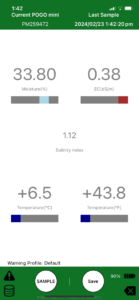
Soil temperature reading taken with a Pogo soil probe.
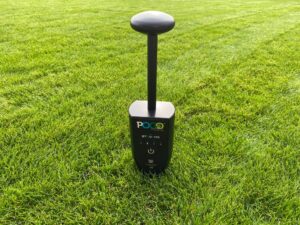
POGO Soil Moisture and Temperature Probe
Three different readings with a Pogo moisture probe give an average soil temperature reading of 6.9 degrees Celcius. So this is fractionally below the required germination temperature for Perennial Ryegrass. These readings were taken at 1pm, so they will drop into the evening and through to the morning. At these levels Perennial Ryegrass will certainly germinate, but it just might take a little bit longer than usual. The photo below shows an area that was sown with grass seed following some road works in the third week of January, it has germinated fine but it has taken 5 weeks to get this far.
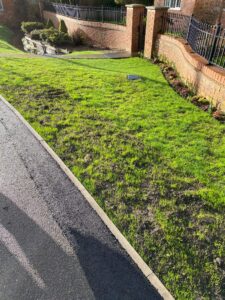
Grass seed germinating in February
Other grass seed types will happily sit in the soil until the conditions are right for them to germinate. Grass seed germination is simply a result of a biological chemical reaction within the seed. Temperature serves as a catalyst in this reaction, increasing the speed of the reaction. If the temperature drops, so does the speed af the reactions and in turn the seed germination.
Do soil types affect grass seed germination?
Soil types certainly do have a big impact on grass seed germination. More specifically it is the amount of moisture held by different a soil type that effects the germination rate.
Soil is basically made up of organic material, mineral material, water and air. As water heats up slower than air, it means that soils that retain more moisture will in turn be slower to warm up. This means that a heavy clay soil will stay colder for longer in the spring. At the other end of the spectrum, a light sandy soil with plenty of soil pores that are full of air will warm up quicker. So in the spring a sandy soil will generally give better grass seed establishment. But be careful, because a sandy soil will be the first to suffer if conditions turn dry!
It is worth mentioning that compact soil can also effect on lawn seed germination. If a soil is too compacted it will hold more moisture, be colder and therefore provide less favourable conditions.
Moisture levels for grass seed germination
If the soil temperature is good the next element to provide the perfect conditions is soil moisture. To get grass seed to germinate it is crucial to keep the soil moist. Grass seed does not need loads of water, but just enough to prevent it drying out and stopping the germination process.
The best way to ensure constant moisture around the seed is to ensure that the seed is incorporated as well as possible into the top 10-15mm of the soil surface. Grass seed that is left on the surface is prone to drying out. With the seed nicely covered by soil all that is required is a light watering to keep up moisture levels.
In the early spring be cautious of applying too much water with a hosepipe. Tap water is always much colder than natural rainfall and can therefore lower the surface temperature, slowing down the seed germination.
Best grass seed for germination
For reliable and quick germination always choose a mixture that contains Perennial Ryegrass, such as our Hardwearing Grass Seed, Multi Purpose Grass Seed or Lawn Repair & Renovation Grass Seed. Ryegrass will make a fantastic lawn whether you are establishing a lawn from scratch or renvoting a lawn as part of a lawn care plan. With required soil temperature of 7 degrees Celcius it means that it is possible to achieve germination from February through to November.
Conclusion
When it comes to sowing grass seed, it does not matter what month is it. What really matters is that the soil temperature is high enough and there is adequate moisture. It can be hard to judge due to our increasingly unpredictable climate in the UK where adverse weather conditions never seem to be far away. If you want to sow grass seed now (end of February), you should be OK but do remember that it will likely take a bit longer than you might usually expect.
Grass seed is something that we often take for granted. We see it every day, we walk on it and we play on it. It is the starting ingredient for a healthy lawn and at the heart of every lawn care plan. But where does grass seed come from and how are lawn seed made? Grass seed production is a specialist business and in this article we will explain the process from the farm all the way to your lawn.
Grass Variety Breeding
What is Grass variety breeding? It’s the process of developing new types or cultivars of grasses through selective breeding techniques. This practice plays a significant role in the production of grass seed, as it ensures the availability of improved and desirable grass varieties for various applications such as lawns, sports pitches, golf courses, parks, and pastures.
Grass seed is not just grass seed! There are many different grass species and within each grass species group there are grass varieties (sometimes called grass cultivars). A grass seed variety is created when a plant breeder selectively breeds grass plants for particular qualities. For example, in perennial ryegrass the focus is often on creating a hard wearing grass seed for football pitches. Bentgrass often gets used in golf greens, so the focus of the breeder there is to create something grass plants with dense grass blades to create a smooth surface.
Selective grass seed breeding and production of grass seed varieties was pioneered by Joseph Barenbrug, founder of the global seed breeding company the Barenbrug Group. The first recognised variety of Perennial Ryegrass, a Perennial Rye grass called Barenza, was produced by Barenbrug was launched in 1948.
Selective breeding of different types of grass seed has resulted in the quality of grass seed increasing dramatically over the last 70 years.
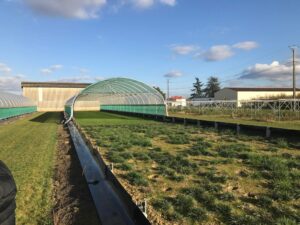
Drought shelter at a grass seed breeding station.
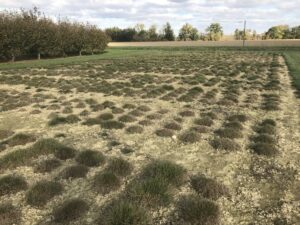
Grass variety selection plots at a breeding station.
Sowing a Grass Seed Crop
Farmers treat a grass seed crop much like a crop of wheat or barley. They start by selecting a field that’s relatively free from weed grasses, which could otherwise contaminate the crop. Then they cultivate the soil to create a fine, firm seedbed that encourages successful germination.
Once the seedbed is ready, sowing begins. Unlike sowing a lawn at home—where you’d typically use 25–35g of seed per square metre—farmers sow grass seed crops at just 1g per square metre. Why the lower rate? It’s all about the goal. A lawn aims for a dense covering of small plants, while a seed crop focuses on fewer, larger plants that can produce more seed.
Farmers can sow grass seed in either spring or autumn, though autumn is usually preferred. Autumn sowing takes advantage of more reliable weather and avoids the risks of extreme heat or drought. In either case, a spring-sown crop won’t be harvested until the following year, as the plant needs to experience winter to trigger its reproductive cycle—a process called vernalisation..
Once sown using a precision seed drill, the seed is rolled into the soil. This crucial step improves seed-to-soil contact, locking in moisture and boosting germination rates. Moisture and soil temperature are key to successful germination, and rolling helps keep conditions just right for the seeds to sprout.
Looking After a Grass Seed Crop
Once the seed is planted, has germinated and has begun to grow, it is a low input crop due to grass seed crops not needing huge amounts of fertiliser. The main task is to ensure it stays free of weeds. There are only a limited number of weedkillers that can be used, so often it is the old fashioned method of pulling out unwanted grass seed heads by hand. This is often performed by large groups of labourers who are mainly looking for unwanted grass seed types.
During the growing process the crop will be subject to periodic crop inspections. These are carried out by a licenced crop inspector who will check that the crop is of a suitable quality and that it meets the descriptive criteria of the individual variety.
A grass seed crop looks just like a field of long grass, so they are very hard to spot. The grass is allowed to grow tall and will produce a flowering seed head, just like a crop of what or barley. It is within this flowering seed head that grass seed is formed and held.
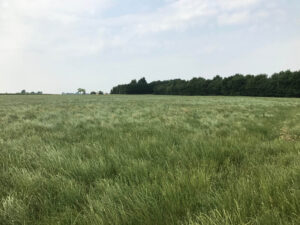
A seed crop of Perennial Ryegrass being grown in the UK.

Red Fescue seed crop grown in the UK.
Harvest Grass Seed
After months of careful management, the seed crop begins to mature and reaches a harvestable stage from July onwards. At this point, the crop becomes highly vulnerable to damage from heavy rain or hail, which can flatten the plants and knock the seed loose. That’s why it’s crucial for farmers to begin harvesting as soon as conditions allow.
Farmers use a combine harvester—often slightly modified for the task—to cut the grass to about 125mm and separate the seed from the leaf blades, stalks, and other plant material. For the process to work effectively, the crop must be dry.
Once harvested, the seed is transferred to barns with ventilated floors that blow fresh, cool air through it. This further dries the seed and prevents overheating, which could reduce germination quality.
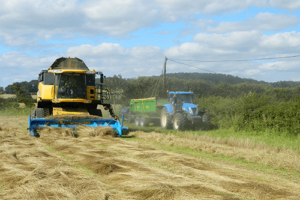
Combine harvester harvesting a crop of grass seed in the UK.
Where is Grass Seed Grown?
A significant amount of grass seed is grown right here in the UK, particularly in the south-east of England where the climate offers ideal growing conditions. The main species cultivated here in the UK are Perennial Ryegrass and Slender Creeping Red Fescue.
Across Europe, major grass seed production also takes place in countries like Holland, Denmark, France, and Germany. The biggest production area in the world is in the USA, specifically in Oregan. The main area famous for grass seed production is the Willamette Valley area. Main grass species grown in the USA are Perennial Ryegrass, Tall Fescue and Kentucky Blue Grass seed.
Where does Grass Seed Online’s seed come from?
We’re proud to grow a significant amount of our grass seed right here in the UK.. We are proud of this because;
- We are supporting UK farmers.
- Home grown is more means it has travelled less miles, which all helps to reduce our carbon footprint.
Grass seed, a crucial component in creating and maintaining lush green lawns, is often stored for future use. However, many gardeners and homeowners wonder if grass seed can go out of date. How long does it keep its viability? Does it have a use-by date? In this article, we will delve into the longevity of grass seed and explore whether it can indeed expire or lose its germination potential over time. Uncovering these facts will help ensure that you make the most of your grass seed investment, fostering healthy growth and vibrant landscapes for years to come. In this artice we will try to answer if the question can grass seed go out of date.
Understanding Grass Seed Viability
Grass seed viability is influenced by several key factors, including the species of grass, storage conditions, and overall quality. Different species of grass have varying levels of seed dormancy and germination requirements, which impact their viability. In addition, the storage conditions, such as temperature, moisture, and exposure to light, can affect the longevity of grass seeds. Overall quality, including genetic purity, seed maturity, and processing methods, also plays a significant role in seed viability.
High-quality grass seeds tend to remain viable longer compared to their lesser counterparts due to a higher level of care when produced and optimal seed maturity. Proper storage techniques can further prolong the shelf life of grass seeds. Seeds should be stored in a cool, dry, and dark environment to minimize degradation. Additionally, using airtight containers or sealed bags can help protect seeds from moisture and pests. A seed producer will conduct monitoring of storage conditions and periodic testing of seed germination to ensure the preservation of high-quality grass seeds.
Understanding the key factors that influence grass seed viability, as well as the importance of high-quality seeds and proper storage techniques, is crucial for maintaining the longevity of grass seeds. Storing your seed mix in dry conditions is of paramount importance. To do this it is advised to keep seed in suitable seed containers to prevent excess moisture and preserve the initial germination rate.
Impact of Seed Ages on Grass Seed Germination Rate
The impact of seed age on germination rate can be significant when it comes to grass seed. The longevity of grass seed is influenced by factors such as moisture levels, temperature, and storage conditions. When grass seed is stored in improper conditions or exposed to high moisture levels and extreme temperatures, its viability decreases significantly as it ages.
Using fresh grass seed can lead to higher germination rates and better lawn establishment. Fresh seed is more likely to have higher viability, resulting in a greater chance of successful germination and healthy growth. Aged seed, on the other hand, can lead to decreased viability and lower success rates. As grass seed ages, its ability to germinate and establish a healthy lawn diminishes, ultimately resulting in patchy or sparse grass coverage.
In conclusion, the age of grass seed significantly impacts its germination rate and overall viability. It is crucial to prioritize the use of fresh grass seed to ensure the best chance of successful lawn establishment and healthy grass growth. Seed that has been kept in a suitable storage environment can however last for an extended period, for example three years or longer. This is why there are no expiration dates for grass seed.
Ideal Conditions for Storing Grass Seeds
Grass seeds should be stored in a cool, dry, and dark environment to prolong their effectiveness. It is important to avoid moisture and humidity as they can cause the seeds to rot, reducing their viability for planting. Direct sunlight can also harm the seeds, so keeping them in a dark place is essential. Rodents are also a threat to stored grass seeds, as they can consume or damage the seeds, so it is crucial to store them in a location that is inaccessible to rodents.
Outdoor storage is not ideal for grass seeds because of the risk of exposure to moisture, humidity, sunlight, and pests. Temperature extremes can also impact the storage of grass seeds, as high temperatures can cause the seeds to lose their viability. Therefore, it is best to store grass seeds in a controlled environment to maintain their quality and effectiveness. In conclusion, the ideal conditions for storing grass seeds involve a cool, dry, and dark environment that is protected from moisture, rodents, and temperature extremes. Using a dustbin with a lid that can be clipped shut is one of the best ways to store grass seed.
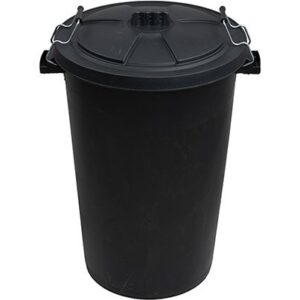
A dustbin which has clips to secure the lid makes an ideal place to store grass seed, preventing moisture and vermin from getting to the seed.
Factors Affecting Germination Rate
The germination rate of grass seed can be affected by several factors including moisture levels, temperature, light exposure, seed quality, and storage conditions. Moisture levels play a crucial role in the germination process as seeds require adequate moisture to activate enzymes and start the growth process. Conversely, excessive moisture can lead to rot and fungal growth, inhibiting germination. Temperature also plays a significant role, as it affects the metabolic processes within the seed. The optimal temperature for germination varies between different grass species, but generally, a moderate temperature range is favourable for germination. Light exposure can have varying effects on different types of grass seed. Some grass species require light for germination, while others can sprout in complete darkness. Seed quality is essential, as high-quality seeds have a higher germination rate compared to lower quality or old seeds. Proper storage conditions are crucial for maintaining seed viability, as exposure to excessive heat, moisture, or light can lead to a decline in germination rates. In conclusion, the viability of different grass seeds (such as Bent, Fescue and Ryegrass) and their ability to sprout are significantly impacted by moisture levels, temperature, light exposure, seed quality, and storage conditions. Proper management of these factors is crucial for achieving successful germination including proper handling of the seed when it is produced.
Conclusion
So can grass seed go out of date? The answer is yes, but if stored well seed can last for around 2-3 years. The top tips are to keep it dry, keep it away from vermin and keep in in a place that avoids extremes of temperature.
How much grass seed do I need for a new lawn from seed?
When it comes to establishing a new lawn from scratch, it’s essential to calculate the correct amount of grass seed needed to ensure a successful and healthy lawn. To determine the quantity of grass seed required, several factors need to be taken into consideration.
Firstly, measure the square metre area of the lawn where the grass will be seeded. This will provide the base value for calculating the amount of grass seed needed. Different types of grass have specific seeding rates, so it’s crucial to choose the most suitable grass for your lawn and follow the recommended seeding rate.
Factors to Consider When Calculating Seed Needs
When planning to seed a new lawn, there are several factors to consider in order to determine how much grass seed you will need. These factors include the size and shape of the lawn, the type of grass you wish to use, the existing soil conditions, and any special features or challenges in your garden. By taking these factors into account, you can ensure that you purchase the correct amount of grass seed and achieve the desired results for your lawn.
First, determine the square meter area of your lawn by measuring its length and width and multiplying these dimensions together. If you have a circular or irregularly shaped lawn, break it down into smaller sections (rectangular or triangular) and calculate the square footage for each section separately. This will help you accurately estimate the total amount of seed needed. To make this easier, try using our grass seed calculator which will work out how much seed you need for a square lawn, rectangular lawn, triangular lawn or circular lawn.
Next, consider the type of grass you want to grow. Different grass types have varying sowing rates, with some requiring more seed per square meter than others. It is important to choose a grass variety that is suitable for your climate, soil type, and usage requirements. All of our grass seed mixes give details of the sowing rate in the product description, see below.
Existing Soil Conditions
The existing soil conditions also play a role in determining seed needs. If you have poor soil quality or excessive weed growth, you may need to overseed or use more seed to achieve a dense and healthy turf. Additionally, if you have a shady lawn or have special features such as slopes, these areas may require more seed for optimal coverage and growth. In such areas it is advisable to increase the sowing rate by up to 50% to allow of the fact that germination rates will be lower.
Consider the soil contact as well. Good seed-to-soil contact is essential for optimal germination and growth. Before seeding, prepare the soil properly by removing any debris, loosening it with a rake, and possibly applying a thin layer of topsoil or compost. Lawn seed needs to be loosley incorporated into the top 5-10mm of top soil, seed that is left on the soil surface will struggle to germinate and successfully establish.
By carefully considering the square metre area, type of grass, soil contact, ideal conditions, and lawn shape, you can accurately determine how much grass seed you need for a new green lawn. Following these calculations will assist in establishing a lush and beautiful lawn.
Grass Seed Sizes
How much grass seed you need depend on the type of grass species used. Different grass seed species have different seed sizes, small seed size requires less seed and conversely large seed size requires more seed. As a guide, in a single gram of seed you would typically find the following*;
Perennial Ryegrass (Lolium perenne) = 700
Red Fescue (Festuca rubra) = 1,000
Hard Fescue (Festucs trachyphylla) = 2,000
Browntop Bent (Agrostis capillaris) = 14,000
Smooth Stalk Meadow Grass (Poa pratensis) = 3,000
So with grass seed sizes in mid, it is important to adjust seed sowing rates accordingly to ensure the correct rate. With seed size for Browntop Bent being much smaller than Perennial Ryegrass, it makes sense that the the sowing rate for Browntop Bent is much less.
Can I sow grass seed too thick?
Sowing grass seed too thickly can lead to several potential issues for your lawn. While it might seem like more seed would result in a more dense turf, excessive seeding can have negative consequences.
When grass seeds are sown too closely together, they have to compete for resources such as sunlight, water, and nutrients. This competition can result in weak, thin grass as the plants struggle for survival. Overcrowded grass can lead to poor air circulation, creating a favorable environment for diseases like fungus.
Fungal infections are more likely to occur when the leaf blades are densely packed and air cannot circulate freely. A turfgrass disease that is likely to occur as a result of an exessive seed rate is Damping Off, which is caused by Pythium, Rhizoctonia, and Fusarium spp fungi. If this occurs there is little that can done, the best way to manage it is to avoid it in the first place.
How much grass seed to sow a lawn from scratch?
To get a healthy, strong lawn you need to get the correct sowing rate. As we have already mentioned, the sowing rate needs to take into account the different factors that will come into play. Things like soil temprature, air temperature and soil condition all come into play. But as a general rule for a typical ryegrass and fescue seed mix a sowing rate of 25-35g/m2 is sufficient. At that rate a 20kg bag will cover anywhere from 570-800m2.
Something to take into account is seed quality. Often cheap lawn seed is cheap becuse it is old or has low germination. Grass Seed Onlineis part of a registered family seed business and we take pride in the quality of the seed we supply.
To accurately work out how much grass seed you will need, try out our grass seed calculator.
*Barenbrug Grass Variety Information https://www.barenbrug.biz/turf/products/grass-varieties
Introduction:
We often get asked by customers if they can buy Kentucky Bluegrass seed here in the UK. Here we explore what it is and answer the questions you may have on it.
Kentucky Bluegrass, scientifically known as Poa pratensis, is a cool-season grass widely utilised in landscaping, lawns, sports fields, and golf courses. Native to Europe and Asia, it thrives prominently in North America, particularly in the state of Kentucky. In the UK, it is recognised by a different name, Smooth Stalked Meadow Grass.
Key Features:
- Versatility and Appearance: Kentucky Bluegrass boasts a fine texture and lush green colour, contributing to visually appealing and attractive lawns when properly maintained.
- Growth Habit: With a spreading growth habit through above-ground rhizomes, it forms a dense and carpet-like turf. This rhizomatous growth makes it popular for turf growers, aiding in soil cohesion and producing robust turf rolls.
- Adaptability: Well-adapted to cool climates, Kentucky Bluegrass is often chosen for regions with cold winters and moderate summers. It is not as heat-tolerant as warm-season grasses.
- Drought Sensitivity: While capable of withstanding moderate drought conditions, it thrives best with consistent moisture.
- Sun and Shade Tolerance: Preferring full sun but tolerating light shade, it is commonly used in sunny lawns but may face challenges in heavily shaded areas.
Popularity in the USA:
In the UK, we enjoy a consistent, temperate climate. However, the northern half of the USA experiences significant temperature swings from summer to winter. Kentucky Bluegrass shines in such climates, tolerating temperature extremes that many other grass species cannot endure. This resilience is particularly evident in regions with freezing temperatures, making it a preferred choice in the USA and even Scandinavian countries.
Drawbacks and Considerations:
While Kentucky Bluegrass offers numerous benefits, it does have a notable drawback. It requires higher temperatures for germination, with optimal soil temperatures ranging from 15-25°C. This translates to a limited sowing window, typically from June to mid-September in the UK. Additionally, it germinates more slowly compared to perennial ryegrass, taking 14-28 days under suitable conditions.
In the UK, perennial ryegrass often outshines Kentucky Bluegrass due to its faster germination, extended sowing window, increased durability, and enhanced visual appeal. However, for regions experiencing prolonged sub-zero weather, Kentucky Bluegrass remains a valuable option.
Availability in the UK:
For those interested in incorporating Kentucky Bluegrass into their landscapes in the UK, you can buy Kentucky Bluegrass seed from Grass Seed Online. Explore the possibilities of this versatile grass for a resilient and visually appealing lawn.
¹Climate in Minnesote, St Cloud State University. https://www.stcloudstate.edu/internationaladmissions/accepted-next-steps/climate.aspx#:~:text=Normal%20daily%20temperatures,Paul.&text=Winter%20in%20Minnesota%20is%20characterized%20by%20cold%20(below%20freezing)%20temperatures.
²Cool-Season Turf Winterkill: Potential Losses and a Pathway to Recovery. Purdue University. https://turf.purdue.edu/cool-season-turf-winterkill-potential-losses-and-a-pathway-to-recovery/
When to sow grass seed?
Introduction:
You want to establish a lawn from seed, you have bought your grass seed and you are ready to sow. But, when is the right time to sow grass seed to establish a lawn from scratch? The key to establishing a brilliant lawn from seed is to find the right time of the year to sow. In this article, we will discuss when is the best month to sow grass seed in the United Kingdom and other important factors to consider before you start sowing your lawn.
What month is best for sowing grass seed?
The best month to sow grass seed in the United Kingdom is generally from mid – Spring through to late-Autumn when soil temperatures are warming up and air temperatures are climbing. Sowing later in Spring or early summer can also be successful but it is likely that sowing too late autumn/winter sowing will result in poor germination rates due to cold soil temperatures and wetter weather conditions.
Sowing grass seed in the spring can sometimes result in more annual and perennial weeds. There are a few reasons for this increase in competition from weeds:
- Weed Competition: Spring is a time when many weed seeds also germinate and start growing vigorously. When you sow grass seed during this season, your newly germinated grass may have to compete with these fast-growing weeds for sunlight, water, and nutrients. Weeds are often more aggressive in spring, potentially outcompeting the grass seedlings.
- Cool Soil Temperatures: Weeds often begin to grow in lower soil temperatures than grass. The result is that soil conditions favour the weed species over the grass. As the temperature increases lawn weeds may establish themselves more quickly in the warmer soil, posing a challenge to the newly sown grass. This is often the case in clay soils that are slow to warm up in the spring, as opposed to sandy soils that will war up quicker. Shady lawns are often cooler in the spring and may be slower to germinate.
- Inconsistent Weather Conditions: Spring weather can be unpredictable, with fluctuating temperatures and varying levels of rainfall. These conditions may create stress for the newly planted grass, making it more susceptible to weed invasion. Weeds are often hardier and can adapt to changing conditions more effectively than newly germinated grass seedlings.
How to minimise weed seed germination:
- Preparation: Prepare the soil thoroughly before seeding to reduce the existing weed population.
- Weed Control: Treat the area with a herbicide, such as glyphosate, that will kill any existing plants but will not affect the new sowings. However, be cautious with herbicide use, as some products may also inhibit the germination of grass seeds.
- Monitor and Remove Weeds: Regularly inspect the area for emerging weeds and remove them promptly to reduce competition with the grass seedlings.
- Choose the Right Grass Species: Select grass varieties that are well-suited to your specific climate and growing conditions. Some grass species may be more resilient against weed competition because they are faster to establish, such as seed mixes containing perennial ryegrass.
By taking these precautions and being attentive to weed management, you can increase the chances of successful grass establishment even when sowing in the spring.
Sowing seed in autumn sowing is very effective due to the combination of high soil temperatures and high air temperatures. To establish your lawn from seed keeping constant moisture around the seed for a couple of weeks is very important. A light watering to keep the soil moist will always help, but in the autumn there is usually more frequent rainfall so this becomes less of a necessity. Another benefit of autumn sowing is that you will not have the danger of heading into a period of hot, dry weather. If you do not have water available, sowing in the spring can be risky if conditions turn dry.
The Royal Horticultural Society has a guide on controlling weeds.
What is the latest time of year to plant lawn seed?
In the United Kingdom, a relatively limited set of grass species is commonly utilized. Perennial ryegrass, red fescues, and bents collectively make up more than 90% of the grass seed employed for lawns in the UK. However, these three species exhibit distinct requirements regarding germination temperatures, influencing the optimal timing for sowing. Here are the temperatures at which one can anticipate favourable germination:
- Perennial ryegrass: 7°C (with a germination period of 7-14 days)
- Red fescues: 11°C (with a germination period of 11-21 days)
- Bent: 15°C (with a germination period of 11-21 days)
While germination can occur below these temperatures, the process is likely to be prolonged due to the biochemical processes of germination slowing down under cooler conditions.
It’s evident that soil temperatures tend to rise in mid-spring and summer, gradually decreasing as we move into autumn and winter. However, the ground exhibits a slow response to warming up and cooling down. This means that, during spring, while air temperatures may be favourable, soil temperatures can lag behind for a considerable period. This characteristic poses challenges, particularly if dry spells occur as we approach summer. In our current climate, achieving optimal conditions can be tricky, with dry spring conditions being a common concern. Despite the warmth in April, the soil may retain its coolness. It’s likely safe to sow, but the germination process might take a bit longer than anticipated.
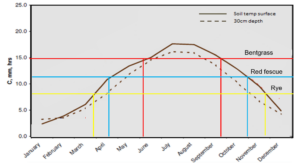
Grass Seed Germination Temperatures
The provided chart illustrates soil temperatures in Edinburgh throughout a 12-month span, juxtaposed with the temperatures required for optimal germination of the three primary grass seed species. The observations reveal significant distinctions.
- Perennial ryegrass: Recommended sowing period extends from mid-March to mid-November.
- Red fescues: Optimal sowing spans from mid-April to late October.
- Bent: Ideal sowing time is from June to mid-September.
Conclusion: A standout finding is that perennial ryegrass boasts the broadest sowing window, with late summer being the prime period. Seeding in autumn offers the best chance for successful lawn establishment. However, if early spring or late autumn sowing is preferred, incorporating perennial ryegrass in the mixture is advisable. Even at less-than-ideal temperatures, grass species can still germinate, albeit at a slower pace. Grass seeds can endure extended periods in the soil before germinating, but prolonged wetness may lead to rot. Choosing when to plant grass seed in the UK is crucial, and when in doubt, opting for a mix with ryegrass is a wise choice.
Additional considerations:
- Seeding in autumn reduces weed competition, especially from annual plants like thistles, whose germination aligns with spring.
- Soil type matters; moist clay soils may take longer to warm up in spring, while sandy soils generally offer warmer conditions, conducive to grass seed germination.
- For winter seeding, grass seed mixtures containing annual ryegrass exhibit better germination in cold soil temperatures.
- Adequate moisture is crucial during seeding, but heavy rain should be avoided, as it may wash away seeds or create a soil surface cap, hindering germination.
Understanding Annual Ryegrass: A Solution to Challenging Conditions
In simple terms, annual ryegrass offers a solution to a common problem in grass seeding. When the weather is too cold for other grass seed varieties, annual ryegrass provides a viable option. Perennial ryegrass, known for its ability to germinate at low temperatures (7 degrees Celsius), is surpassed by annual ryegrass, which has demonstrated germination capabilities as low as 4 degrees in laboratory trials*. This makes annual ryegrass the best grass seed for sowing in the winter.
Life Cycle and Uses
Annual ryegrass, scientifically known as Lolium multiflorum, has a distinct life cycle, completing its growth within a year. Similar to other annual plants like poppies or cornflowers, it germinates, produces leaves and shoots, flowers, produces seeds, and then naturally dies off. These plants establish quickly, a crucial characteristic for their survival as they need to produce seeds rapidly for the next generation to thrive.
In recent years, plant breeders, notably international grass seed breeder Barenbrug, have enhanced the desirable low-temperature germination qualities of annual ryegrass. Barenbrug successfully developed annual ryegrasses specifically designed for turf or sports applications. By gradually reducing the size of traditional annual ryegrass plants, they created varieties comparable to conventional perennial ryegrass. The outcome is a range of grass seed mixtures that enable grass establishment during periods when it was previously challenging.
Pitch Perfect: Winter Sports Solutions
A primary application of these grass seed mixtures is on football and rugby pitches during the winter playing season. Winter sports pose challenges for groundkeepers due to pitch wear during slow growth periods. Traditional repairs without modern technologies like under-soil heating and heat lamps can be difficult. However, a grass seed mixture containing annual ryegrass becomes a valuable solution for repairing damaged areas such as goalmouths and touchlines. Increasingly groundsmen are turning to annual ryegrass grass seed for sowing in the winter.
Short-Term Strategy
Given the short lifespan of annual ryegrass, it’s crucial to combine it with conventional perennial ryegrass seed. The perennial ryegrass seed remains in the soil, germinating when spring temperatures become suitable. Eventually, as the annual ryegrass dies back, the perennial ryegrass takes over, ensuring continuous coverage.
Beyond Sports: Versatile Applications
While annual ryegrass finds considerable use in sports, its versatility extends to various areas requiring coverage in low temperatures. It proves effective for repairing road verges, lawns, and even steep slopes. Due to its rapid germination, annual ryegrass is often included in grass seed mixtures for embankments, stabilizing the soil quickly and acting as a nurse crop for other grasses as they germinate and establish.
*Lin, Jixiang & Hua, Xiaoyu & Peng, Xiaoyuan & Dong, Bolin & Yan, Xiufeng. (2018). Germination Responses of Ryegrass (Annual vs. Perennial) Seed to the Interactive Effects of Temperature and Salt-Alkali Stress. Frontiers in Plant Science. 9. 1458. 10.3389/fpls.2018.01458. https://www.researchgate.net/publication/328166309_Germination_Responses_of_Ryegrass_Annual_vs_Perennial_Seed_to_the_Interactive_Effects_of_Temperature_and_Salt-Alkali_Stress
When to plant grass seed in the UK?
Introduction
When to plant lawn seed in the UK is one of the most common questions we get from customers. Establishing a healthy lawn from seed is all down to giving it the best start. But to give it the best start it is vital to sow it at the right time of year. In this article we will look at soil temperatures and the effect they have.
Different require different temperatures
In the UK we only use a relatively small set of grass species. Perennial ryegrass, red fescues and bents account for over 90% of grass seed used in the UK for lawns. But these three species have different requirements when it comes to germination temperatures. This in turn effects when is is best to sow them. Below are the temperatures at which you would expect ‘good’ germination.
Perennial ryegrass = 7°C (7-14 days)
Red fescues = 11°C (11-21 days)
Bent = 15°C (11-21 days)
Germination will occur below these temperatures. But it is likely to take longer due to the biochemical processes of germination slowing down.
Soil temperatures in the UK
It is obvious to say that soil temperatures increase as we enter the mid – spring and summer and decline into autumn and winter. However the ground is slow to warm and slow to cool down. This means that in the spring the air temperatures can be good, but soil temperatures can lag behind for a while. For this reason spring months can be challenging, especially if there are dry spells as we head into the summer. With our current climate finding perfect conditions can be hard, dry spring conditoins being a regular issue. The weather in April may feel warm, but the soil can be cold. Chances are it will be fine to sow, but the seed may take a little longer than expected.
The effect on seed germination

The effect of soil temperature on germination times of different grass seed species in the UK.
The above chart plots the soil temperatures in Edinburgh over a 12 month period. Plotted against it are the temperatures required for ‘good’ germination from the three main grass seed species. The result shows a big difference.
Perennial ryegrass = mid-March to mid-November
Red fescues = mid-April to late October
Bent = June to mid-September
Conclusion
The stand out piece of information is that perennial ryegrass has the widest sowing window and late summer is the optimum time. If you seed in autumn you are giving your lawn the seed the best chace of succesful establishment. But if you are looking to sow early in the spring or late in the autumn, use a mixture containing perennial ryegrass. Even at sub optimal temperatures, grass species can still germinate but they will just take longer. Grass seed can survive in the ground for prolonged periods before germinating. But it must not sit permenently wet, otherwise it is likely to rot. When to plant grass seed in the UK is an important question to get right, but if in doubt choose a grass seed mix with ryegrass.
Other things to consider:
- Seeding in the autumn months results in less competition from weeds. Weed seeds from annual plants like thistles are less likely to be a problem as thier germination process favours the spring.
- Your soil type and soil conditions should be considered. Moist soils such as clay soils can take longer to warm up in the spring. Conversely, sandy soil is generally warm soil, which is great for grass seed germination.
- If the autumn months pass and you need to look at seeding in the winter months, there are types of grass seed that can help. Grass seed mixtures containing annual reygrass have better levels of germination in chilly soil temperatures.
- It is important to have adequate moisture levels when seeding, but it is best to avoid periods of heavy rain. Torrential rain can cause seed to be washed away or cap the soil surface, resulting in seed struggling to germinate.
References: Braun, Ross & Patton, Aaron & Watkins, Eric & Hollman, Andrew & Murphy, James & Park, Bradley & Kowalewski, Alexander & Braithwaite, Emily. (2021). Optimal fine fescue mixture seeding dates in the Northern United States. Agronomy Journal. 113. 10.1002/agj2.20859. https://www.researchgate.net/publication/353984830_Optimal_fine_fescue_mixture_seeding_dates_in_the_Northern_United_States